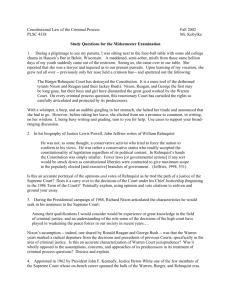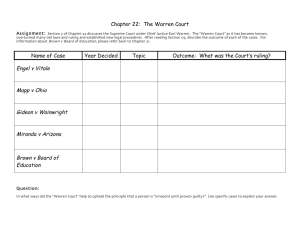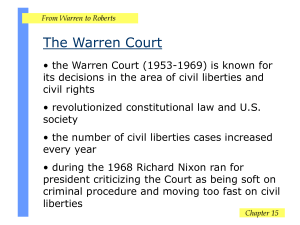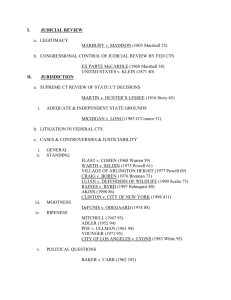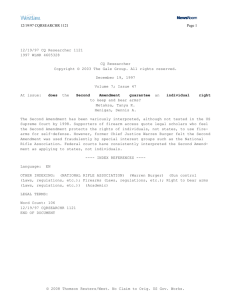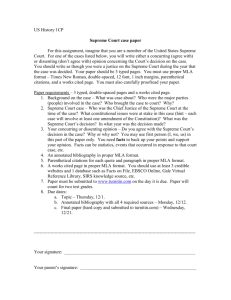Warren Court vs. Renquist Court
advertisement
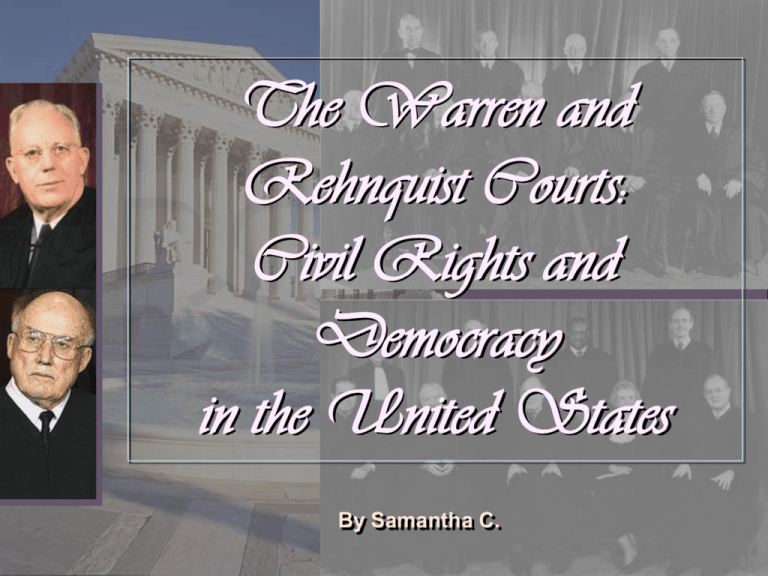
The Warren and Rehnquist Courts: Civil Rights and Democracy in the United States By Samantha C. Historical Question As conveyed by the Warren (19531969) and Rehnquist (1986-2005) Courts in the context of their respective eras, to what extent did each Supreme Court play a role in civil rights and democracy in the United States? Origins of the Civil Rights Movement I. The Legacy of World War II The war effort Economy revived, job opportunities for blacks Urban black middle class thrived Leaders of black communities lead civil rights movement Black colleges and universities had expanded Students and educators contribute to civil rights movement The Cold War The Red Scare, McCarthy Korean War ended in July 1953 Proxy war U.S. not successful America: freedom and justice; Soviet Union: enemy of freedom Irony: racism is an injustice, an embarrassment II. Urban Trends The “Second” Great Migration (1940-1960) South (rural) North (urban) Northern Blacks in Politics Bloc in Democratic Party Labor unions Popular Culture: Television: Wealthy white families Images of demonstrators Sports: Jackie Robinson Rock and Roll “Race music” E.g. Elvis Presley Above, the handshake with George (Shotgun) Shuba of the International League's Montreal Royals (left), teammate of Jackie Robinson, after Robinson’s third-inning home run April 18, 1946; Roosevelt Stadium; Jersey City, N.J. Pre-Court Opinions Warren Reston, 1953 About the times: “Nothing has divided the nation in the post-war era more than questions involving racial segregation or the freedoms … protected by the First Amendment” About Warren: “As Governor of California, he generally was ranked with the liberals in his party” Rehnquist 1971, the year Rehnquist is appointed a justice aide Rehnquist is quoted as saying, “I am opposed to all civil rights laws” in an affidavit Warren and Rehnquist Both Warren and Rehnquist address all of the following issues at one point in term of office as Supreme Court Chief Justice: Civil rights (race) Voting Criminal procedures Religion Only the Rehnquist Court addresses gender/sex issues In general, they ruled for opposing causes Things to Think About Focus: who protects the individual, and the rights of that individual, in our society? Democracy: How does the individual fare in this country under a given court? Common thread: Amendments being looked at, used, how each court interprets the amendments What amendment is being used? What part(s)? How used? A court uses part of the Constitution to support a given view or position People’s reactions Unanimous or divided: reflection of the country Civil Rights: The Warren Court Brown v. Board of Education of Topeka, Kansas (1954) Brown v. Board of Education Earl Warren’s reading copy of Brown opinion May 17, 1954 “unanimously”, “Separate educational facilities are inherently unequal” “rejected” Plessy vs. Ferguson Justification: the Fourteenth Amendment – “equal protection of the laws” Brown, For and Against Pro-Brown Chicago Defender, June 12, 1954 (right) Anti-Brown John Kennedy, Arkansas Democrat, May 22, 1954 (left) Significance of Brown for Civil Rights Integration of schools equal opportunity for success, employment The Warren Court reveals itself as a liberal, activist court Liberal court: for human, individual, civil rights Activist court: the Supreme Court assumes responsibility for the racial status of public education in the nation Unexpected: Warren follows FDR and the New Deal Rejects the Jeffersonian Ideal: “The government that governs least governs best” The Warren court view: states hinder the improvement of justice in America Brown desegregation of the entire country The federal government has finally begun to enforce the 13th, 14th, and 15th Amendments The Desegregation Crisis Little Rock, AK (Summer 1957) National Guard White mobs televised Eisenhower Federal troops to protect The “Little Rock Nine” • • • Desegregation of other public facilities Montgomery Bus Boycott, 1956 Rosa Parks Dr. Martin Luther King, Jr. Supreme Court: Segregation of buses is unconstitutional Dec. 20, 1956 Civil disobedience in Greensborough, NC, 1960 Freedom Riders, 1961-1965 Southern white retaliation – June 1963: Jackson, Mississippi March on Washington, 1963 Counts, Will. September 1957. Little Rock, AK. Attack on the Warren Court The Birch Society: a far right wing organization Conducted an essay contest on “Grounds for the Impeachment of Earl Warren” 1961 President Whitney North Seymour of the American Bar Association says: “Leave such attacks to the Communists who hate our institutions” – this response is a reflection of Cold War hostilities Congress Responds Civil Rights Acts:1957, 1964, 1965 Liberal to Conservative in the Nation 1960s: liberal - Civil Rights, President Andrew Johnson’s Great Society, U.S. GNP up 31% The Nixon Presidency (1969-1974): the Watergate Scandal Trust in federal government diminished The Vietnam War: The U.S. expected to win costly, long, brutal failure U.S. focused on international affairs rather than domestic economic and racial problems anti-war movement Civil Rights: threatened employ of white people Militant, extremist black groups, e.g. the Black Panthers, the Nation of Islam Economy of 1970’s: inflation, recession, unemployment, huge deficit in balance-of-payments materialism and consumerism People hated excessive taxation and regulation Energy Crisis 1973-4 Distrust of a liberal, activist government the people of the U.S. wanted deregulation of economy by govt The 1980s: Reagan Conservatism The 1980s Ronald Reagan (1981-1989): The Reagan Years Decentralization in political and economic worlds Reaganomics: tax cuts diminished stagflation 1983: beginning of the longest U.S. bull market in history New technology was changing the economy Social conscience with new dangers: AIDS, environment, crime and assassinations Oprah Winfrey tabloid talk shows popularized Issues for public awareness, e.g. homosexuality On an international scale: Rise of Islamic Fundamentalism 1989: Fall of the Berlin Wall end of the Cold War Increased, improved telecommunications across continents 1989: Democratic, anti-communist revolutions, e.g. Tiananmen Square protests, China Reagan doctrine: the U.S. supported anti-Communist or anti-Soviet rebellions, 1989 Civil Rights: The Rehnquist Court Affirmative Action In the 90’s: Civil Rights issues : affirmative action How do we redress grievances from systemic racism? Implementation of desegregation Bakke v. Regents of the University of California (1978) – before the Rehnquist Era: Race as a factor in student admissions, in order to achieve “student body diversity”, is constitutional (does not violate 14th Amd.) Hopwood v. Texas (1996) challenged Bakke v. Regents Effectively banned affirmative action in LA, TX, MS Johnson v. Board of Regents of the University of Georgia (2001) openly questioned Bakke Grutter v. Bollinger (2003) Decision: 5 – 4 : If race factor not weighted or deciding, constitutional in admissions process; re-affirmed Bakke, overriding Hopwood Rehnquist was in the dissent (Left) Gallup poll of public’s attitude towards public schools Democracy and Voting: The Warren Court Voting: Baker v. Carr (1962) “The reapportionment case” Question: Does the Supreme Court have jurisdiction over questions of legislative apportionment? Or is it only a political question? Decision: Vote of 6 – 2: Yes Judicial, not political issue: Fourteenth Amendment Votes before re-apportionment were “unconstitutionally based, since the equal protection clause [prohibits] arbitrary and unreasonable apportionment of legislative seats” Legal Impact: 14th Amendment equal protection “one person, one vote”, or “per capita equality of representation Changed political representation in the U.S. Reapportionment Revolution 1960s Supreme Court extending power into state-level affairs Focused “the public eye” so closely on the Supreme Court’s actions The 2000 Election and the Rehnquist Court Florida Above: “The Butterfly Ballot” Palm Beach County, FL Al Gore vs. Pat Buchanan 3,000+ voted for Buchanan by mistake 19,000+ double-punched Buchanan over-vote. Palm Beach County: right-most bar, almost three times the over- vote of the next highest Blue: punch ballot Yellow: optical ballot Undervote average: 1.5% in counties with punch ballot; 0.6% in counties with optical unequal protection: The Fourteenth Amendment, makes an argument for manual recounts of votes in Florida Bush v. Gore uses the argument of equal protection against manual recounts African-American Opinion: Florida Poll, 2001 • • • • Equal protection Fourteenth Amendment rights violated More than 80% believed that more blacks’ votes were rejected than nonblacks’ votes Around 30%, either he/she or a friend, “denied fair access to voting” 40-54% thought black votes were treated differently because of a “coordinated effort by state government to make it more difficult for African Americans to vote” Bush v. Palm Beach County Canvassing Board (2000) Monday, December 4 Rather than affirm or overturn the Florida Supreme Court’s decision, the Supreme Court asks why the lower court made its ruling Wanted to see whether the Florida high court’s interpretation of Florida law circumvented legislative authority This circumstance would have violated Article II, Section 1 of the Constitution, for the appointment of electors from each state “in such Manner as the Legislature thereof may direct” Bush v. Gore Question: Did the Florida Supreme Court violate the Equal Protection and Due Process Clauses of the Constitution by allowing hand recounts without set standards? Another issue: the December 12 “safe harbor” deadline for the recounts Decision: (7 – 2 ruling) Recounts in Florida unconstitutional halted Procedure of recounting might not be the same for each county; denied equal protection under the 14th Amendment There was only one day for the recounts to take place, not enough time for a constitutionally valid recount Immediate halt to manual recounts was upheld (5 – 4 ruling) Also, on the basis of Article II, Section I, Clause 2 of the Constitution: “Each State shall appoint, in such Manner as the Legislature thereof may direct, a Number of Electors” Significance of Bush v. Gore The individual votes of the people need not be recounted, as the United States of America does not conduct direct election This part of the decision is going against the principle of “one person, one vote” established in Baker v. Carr (1962) of the Warren Court Stare decision: The Supreme Court’s decisions are to be recognized as set precedents; yet… “Our consideration is limited to the present circumstances, for the problem of equal protection in election processes generally presents many complexities.” For this statement in the majority opinion, departing from the principle of stare decisis, Bush v. Gore received much criticism Political Cartoonists Respond By Don Wright, The Palm Beach Post, November 26, 2000 Irony: The Supreme Court majority under Rehnquist was usually pro-states’ rights; for the presidential election of 2000, the Supreme Court overturned the ruling in the Florida Supreme Court By Daryl Cagle, The Honolulu Advertiser, December 4, 2000. The Supreme Court decision in Bush v. Gore effectively put George Bush into office Response to Bush v. Gore Chief Justice William H. Rehnquist and Justices Sandra Day O' Connor, Antonin Scalia, Anthony M. Kennedy, and Clarence Thomas The Bush Decision December 13, 2000 by Ann Telnaes What’s underneath, behind the decision, under the cloak of the Supreme Court, is politics Criminal Procedures: The Warren Court Mapp v. Ohio (1961) Search and seizure Question: “May evidence obtained by a search in violation of the Fourth Amendment be used in state criminal proceedings?” Decision: Vote of 6-3 “all evidence obtained by searches and seizures in violation of the Constitution is, by [the Fourth Amendment], inadmissible in a state court.” Legal impact: controversy: exclusion of illegally obtained evidence from all court levels Gideon v. Wainwright (1963) Right to counsel in criminal procedure Question: For non-capital and capital cases, must states appoint counsel to defendants who cannot pay? Unanimous decision, 9 – 0 Now, the 6th Amd. applicable to the states by 14th Amd., and as such it required counsel to defendants in state criminal trials, charged with serious offenses Legal Impact: Two series of cases followed: the right itself to counsel under the 6th Amd,, and at what stages in the criminal justice system the defendant must be allowed counsel Concerned standards of effective counsel to determine when the right to such has been denied to the defendant Felony cases Argersinger v. Hamlin (1972) extended the right to misdemeanor Today: public defender offices; in some regions, private attorneys hired judges Miranda v. Arizona (1966) Escobedo v. Illinois (1964): right to counsel Miranda v. Arizona (1966) Question: Do police interrogation practices on individuals, without having notified them of their protection against selfincrimination and their right to counsel (established by Gideon), violate the Fifth Amendment? An unusual 5 – 4 decision Incriminating evidence said by the suspect cannot be used if strict procedure were not adhered to A “law enforcement system that depends on the confession is inherently less reliable and more subject to abuse than a system that depends on extrinsic evidence” Legal Impact: Guidelines for custodial interrogations The suspect-police and citizen-state relationships changed Criminal convictions are now based on a solid foundation of evidence, not confessions made under questionable circumstances Terry v. Ohio (1968): Search and seizure in criminal procedure Question: Were Terry’s Fourth Amendment rights violated by the police officer? Decision: Ruling of 8 – 1, it seems the opposite ruling of Mapp v. Ohio, but circumstances were different Significance: “Reasonable suspicion”; protection of individuals under 4th Amd. weakened Officer’s power is still checked; the search must be limited in scope and/ or for the goal of the officer’s own protection Criminal Procedures: The Rehnquist Court Colorado v. Connelly (1986) Involuntary confession Francis Connelly, a man suffering from chronic schizophrenia at the time, confessed to murder to a policeman without prompting Question: Does the use of Connelly’s statements as evidence violate the Due Process Clause of the Fourteenth Amendment? Decision: this evidence could be used, though the man’s “rational intellect” and “free will” had interference due to mental state Limits the scope of Miranda v. Arizona interpretation “Miranda protects defendants against government coercion leading them to surrender rights protected by the Fifth Amendment; it goes no further than that” McCleskey v. Kemp (1987) Question: Does sentencing McCleskey to death violate the Eighth and Fourteenth Amendments based on the statistical study, the Baldus study, showing that a black defendant who killed a white victim is most likely of all racial combinations to be sentenced to death in the state of Georgia? Decision: 6 – 3 The statistical study did not provide substantial evidence to require a reversal of conviction; it could not be proven that discrimination had affected McCleskey in this particular trial Therefore, the death penalty for this man was constitutional The legislative rather than judicial branch of government is better suited for presenting data Dissent: evidence of racial bias in cases addressing capital offenses To those against the ruling, the decision was pro-death penalty, racist (not looking at racism in the case) Dickerson v. United States (2000) Under 18 USC Section 3501 "a confession shall be admissible in evidence if it is voluntarily given." Question: May Congress overrule Miranda v. Arizona, and its warnings, through legislation? Decision: 7 – 2 Rehnquist held that Miranda mandates under what circumstances to accept statements made during custodial interrogation, in both state and federal courts "Miranda has become embedded in routine police practice to the point where the warnings have become part of our national culture," wrote Rehnquist. "Miranda announced a constitutional rule that Congress may not supersede legislatively. We decline to overrule Miranda ourselves" It is possible that the culture of the U.S. itself influenced this decision, which seems to be more on the side of the individual, unusual for the Rehnquist court Atwater v. City of Lago Vista (2001) Background: Texas Law held it a misdemeanor for a person sitting in the passenger seat of a vehicle equipped with seatbelts not to wear one Atwater was pulled over, handcuffed, imprisoned Question: Does the Fourth Amendment limit the authority of a police officer to arrest without a warrant for a minor criminal offense? In this case, are common-law restrictions on misdemeanor cases implicit to the Fourth Amendment? Decision: 5 – 4 The Fourth Amendment does not prohibit a warrant-less arrest for a minor criminal offense "If an officer has probable cause to believe that an individual has committed even a very minor criminal offense in his presence, he may, without violating the Fourth Amendment, arrest the offender" – Justice Souter wrote This decision is reminiscent of the “reasonable suspicion” precedent set by Terry v. Ohio (1968), but this time with a divided court ruling of 5 – 4 Religion: The Warren Court Engel v. Vitale (1962) Background: Small, non-denominational prayer for school children in public schools “Almighty God, we acknowledge our dependence upon Thee, and beg Thy blessings upon us, our teachers, and our country. Amen” Question: Does the prayer violate the First Amendment “establishment of religion” clause? This decision was 6 – 1, as Justices Frankfurter and White were unable to vote Yes, even under the non-compelling conditions of the prayer, the prayer is unconstitutional, a religious activity by nature Legal Impact: Series of cases: Establishment Clause of the First Amendment to the Constitution was used to rid of different kinds of out-of-context religious activities Religion had, up to this point in history, been a part of public ceremony Religion: The Rehnquist Court Rosenberger v. Rector and Visitors of the University of Virginia (1995) Background: University of VA had students make mandatory monetary contributions to the University’s Student Activity Fee (SAF) money for printing costs for student organizations “Wide Awake: A Christian Perspective” denied funding by UVA’s SAF because a Christian-oriented magazine Question: Does denial of funding to a magazine that “primarily promotes or manifests a particular belief in or about a deity or an ultimate reality” violate the Free Speech Clause of the First Amendment? Does the granting of funds from SAF to a religiously inclined paper in UVA violate the Establishment Clause of the First Amendment? Decision: 5 – 4 The government cannot regulate speech based upon content or message The granting of funds does not violate the Establishment Clause because the money was not raised by taxes, and the student publication is neither a religious institution nor a religious organization Significance of Rosenberger v. Rector Public facilities could thenceforth be used for religiouslymotivated presentations, as a form of free speech Distinguished between content discrimination (potentially allowed) vs. viewpoint discrimination (banned), in the distribution of activities funds This may remind one of “reasonable suspicion” vs. unreasonable suspicion in Terry v. Ohio (1968) of the Warren Court Relevance to today: As mandatory funding had created such controversy that it led to a Supreme Court case, a relevant, conciliatory ad appeared in The Cavalier Daily on March 23, 2006: “Any student who objects to the use of his or her Spring 2006 Student Activities Fee payment to support particular speech activities may obtain a refund of $5.75 of that payment” Gender/Sex: The Rehnquist Court Abortion Roe v. Wade (1973) – prior to Rehnquist Era Question: Does the Constitution embrace the right of a woman to have an abortion? Decision: 7 – 2: Yes right to privacy protected by the Fourteenth Amendment Woman: total autonomy during first trimester different state laws for second and third trimesters Affected legislation in 46 states Webster v. Reproductive Health Services (1989): again, 5 – 4 decision Chief Justice Rehnquist: majority decision Roe v. Wade was not explicitly overruled, but abortion restrictions were upheld Planned Parenthood v. Casey (1992): a re-examination of Roe Decision: 5 – 4, upheld the validity of Roe Rehnquist dissents Abortion in the New Millennium Stenberg v. Carhart (2000) Decision: 5 – 4, struck down state-level attempts to ban late-term abortions Justice William Rehnquist consistently does not believe that abortion is a protected right; "privacy" is not explicitly mentioned in the Constitution State Opposition: South Dakota March 6, 2006: Governor Mike Rounds of South Dakota signed into law a bill passed by the South Dakota State Legislature According to SD law: any abortion is a felony, including one to terminate a pregnancy resulting from rape and incest The bill makes no exception for the health of a woman, and scarcely allows an exception to save the life of the mother This may lead to another Supreme Court Case in the near future The sponsors of the SD law hope that Roe will be overturned Violence Against Women Act of 1994 Violence Against Women Act of 1994 Provided $1.6 Billion for the prosecution of violent crime perpetrated against women Increased pretrial detention of the accused Mandated immediate sentences for those convicted Allowed civil redress if a case not pursued by prosecutor U.S. v. Morrison (2000): 5 – 4 decision Part of the VAWA unconstitutional Not provided for in either the Commerce Clause or the Fourteenth Amendment to the Constitution Congress contradicted the Supreme Court’s decision by re-authorizing the legislation in 2000, and again in 2005; the next re-authorization is to be 2010. Romer v. Evans (1996): Civil rights of homosexuals Question: Does Amendment 2 of the Colorado State Constitution, which prohibits extension of official protections to victims of discrimination due to sexual orientation, violate the Equal Protection Clause of the Fourteenth Amendment? Decision: 6 – 3 Amendment 2 explicitly denied equal protection of the law to homosexual and bisexual persons Amendment 2 targeted a certain group and weakened their legal protections – a clear violation of 14th Amd. This cannot be justified as having a “legitimate government interest” Justice Kennedy: "If the constitutional conception of 'equal protection of the laws' means anything, it must at the very least mean that a bare desire to harm a politically unpopular group cannot constitute a legitimate governmental interest" Again, Rehnquist dissents Gender: Exclusive to Rehnquist Gender and sexual orientation were not issues during Warren Era However, these are Civil Rights issues Had Warren been presented with these cases, he most likely would have made different decisions than did Rehnquist Warren vs. Rehnquist on Race This ties together Civil Rights, Criminal Procedures Warren: Pro-individual Takes into account race and minority status Made a connection between race and punishment for criminality Rehnquist: Does not use race in any context Would not accept any sociological studies that show race as an issue; no study interferes in decision Warren Court vs. Rehnquist Court Warren had a united court Though the South was a region unto its own, there was a liberal consensus during the Warren Era Warren Court reflected the nation, and gave it legal leverage to transform the country Rehnquist had a divided court Rehnquist Court was faced with even more controversial issues than was Warren There was no particular trend in the nation as a whole towards one opinion The world is more complicated Civil rights and democracy are being distorted by traumatic events, e.g. 9/11 Works Cited Beck, Joan. “What if Roe were overturned?”. Chicago Tribune 25 July, 1985. “Birth Society Assailed for ‘Vilification’: Bar Head Condemns Attack on Warren.” Chicago Daily Tribune 8 Aug., 1961. Cagle, Daryl. The Honolulu Advertiser 4 Dec., 2000. Chicago Defender [political cartoon] 12 June, 1954 <http://www.landmarkcases.org/brown/defender.html> Counts, Will. [Photograph] September 1957. Little Rock, AK. DeCesare, Dale. “ECS Policy Brief: Affirmative Action”. July 2003 <http://www.ecs.org/clearinghouse/32/15/3215.htm> Dubiner, Michael. 2000 <http://duby.com/Election2000.html> Elam, Stanley M., Lowell C. Rose, and Alec M. Gallup. “The 28th Annual Phi Delta Kappa/Gallup Poll of the Public’s Attitudes Toward the Public Schools”. <http://www.pdkintl.org/kappan/kpoll284.htm> “2000 Election Timeline”. The Authentic History Center. <http://www.authentichistory.com/images/2000s/election_2000/timeline/2000selectiontime line.html> FindLaw. 2006 <http://www.findlaw.com/casecode/index.html> Graham, Fred P. “Rehnquist’s Statements Indicate He Would Be an Activist Pressing Conservative Views”. The New York Times 3 Nov., 1971. Kennedy, John. “No job for a race horse.” Arkansas Democrat 22 May, 1954 <http://www.landmarkcases.org/brown/democrat.html> Lewis, Chris H. “Question for Discussion: What were the major factors that caused the growth of the Black Civil Rights movement after World War II?” American Studies 2010 <http://www.colorado.edu/AmStudies/lewis/2010/civil.htm#bot> McCloskey, Robert G. “The Supreme Court, 1961 Term”. Harvard Law Review Vol. 76 No. 1 (Nov. 1962): 54-222. Nemacheck, Christine L. “The 2000 Florida Election Cases: Politics over Principles”. Historic U.S. Court Cases: An Encyclopedia. Ed. John W. Johnson. Great Britain: Routledge, 2001. Works Cited (cont’d) Pearson, Drew. Diaries 1949-1959. Ed. Tyler Abell. New York: Holt, Rinehart and Winston, 1974. Pollack, Jack Harrison. Earl Warren, the Judge Who Changed America. New Jersey: Prentice Hall, 1979. Popham, John N. “Warren, In South, Scores Prejudice”. The New York Times 26 Sept., 1954. Powe, Jr., Lucas A. The Warren Court and American Politics. Rehnquist, William H. The Supreme Court. New York: Alfred A. Knopf, 2001. “Refunds for Rosenberger”. The Cavalier Daily 24 March, 2006 <http://www.cavalierdaily.com/CVArticle.asp?ID=26433&pid=1419> Roper, David L. “Florida 2000 Presidential Vote”. Politics. <http://arts.bev.net/roperldavid/politics/FL2000.htm> Telnaes, Ann. The Bush Decision. 13 December 2000 <http://www.loc.gov/exhibits/telnaes/telnaes-pulitzer.html> “The Japanese Camps in California”. Journal of Historical Review. Institute for Historical Review <http://www.ihr.org/jhr/v02/v02p-45_Weber.html> Tushnet, Mark. A Court Divided: the Rehnquist Court and the Future of Constitutional Law. New York: W.W. Norton & Company, Inc., 2005 United States. Northwestern University. OYEZ U.S. Supreme Court Multimedia. 2005 <http://www.oyez.org/oyez/resource/case/> Waldron, Martin. “Rehnquist Is Described As a Firm Conservative”. The New York Times 28 Oct., 1971. Warren, Earl. The Memoirs of Chief Justice Earl Warren. Garden City: Doubleday & Company, Inc., 1977. Wikimedia Foundation, Inc. Wikipedia. 2006 <http://en.wikipedia.org/wiki/Supreme_court_cases> Wright, Don. “Civics Quiz”. The Palm Beach Post 26 Nov., 2000.
